
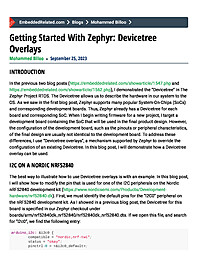
Getting Started With Zephyr: Devicetree Overlays
In this blog post, I show how the Devicetree overlay is a valuable construct in The Zephyr Project RTOS. Overlays allow embedded software engineers to override the default pin configuration specified in Zephyr for a particular board. In this blog post, I use I2C as an example. Specifically, I showed the default I2C pins used for the nRF52840 development kit in the nominal Zephyr Devicetree. Then, I demonstrated how an overlay can be used to override this pin configuration and the final result.
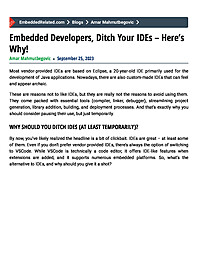
Embedded Developers, Ditch Your IDEs – Here’s Why!
Ditching your Integrated Development Environment (IDE) temporarily can be a transformative learning experience in embedded development. This post invites you to explore the underpinnings of IDEs by delving into alternative tools and processes like Makefile, CMake, Vim, GDB, and OpenOCD. Understanding these tools can demystify the background operations of IDEs, revealing the intricacies of compiling, linking, and debugging. This journey into the “under the hood” aspects of development is not just about learning new tools, but also about gaining a deeper appreciation for the convenience and efficiency that IDEs provide. By stepping out of your comfort zone and experimenting with these alternatives, you can sharpen your skills, enhance your knowledge, and possibly discover a more tailored and streamlined development experience. Whether you're a novice or a seasoned developer, this exploration promises insights and revelations that can elevate your embedded development journey.
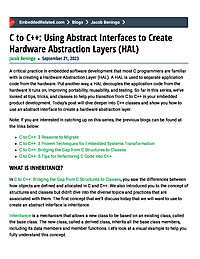
C to C++: Using Abstract Interfaces to Create Hardware Abstraction Layers (HAL)
In C to C++, we've been exploring how to transition from a C developer to a C++ developer when working in embedded system. In this post, we will explore how to leverage classes to create hardware abstraction layers (HAL). You'll learn about the various inheritance mechanisms, what an virtual function is, and how to create an abstract class.
Are We Shooting Ourselves in the Foot with Stack Overflow?
Most traditional, beaten-path memory layouts allocate the stack space above the data sections in RAM, even though the stack grows “down” (towards the lower memory addresses) in most embedded processors. This arrangement puts your program data in the path of destruction of a stack overflow. In other words, you violate the first Gun Safety Rule (ALWAYS keep the gun pointed in a safe direction!) and you end up shooting yourself in the foot. This article shows how to locate the stack at the BEGINNING of RAM and thus point it in the "safe" direction.
nRF5 to nRF Connect SDK migration via DFU over BLE
This writeup contains some notes on how I was able to migrate one of my clients projects based on the nRF5 SDK, to nRF Connect SDK (NCS) based firmware, via a DFU to devices in the field over BLE.
Who needs source code?
Many developers feel that the supplying source code is essential for licensed software components. There are other perspectives, including the possibility of it being an actual disadvantage. Even the definition of source code has some vagueness.
New book on Elliptic Curve Cryptography
New book on Elliptic Curve Cryptography now online. Deep discount for early purchase. Will really appreciate comments on how to improve the book because physical printing won't happen for a few more months. Check it out here: http://mng.bz/D9NA
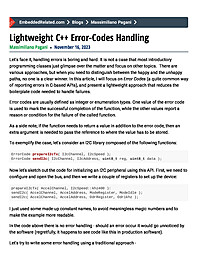
Lightweight C++ Error-Codes Handling
The traditional C++ approach to error handling tends to distinguish the happy path from the unhappy path. This makes handling errors hard (or at least boring) to write and hard to read. In this post, I present a technique based on chaining operations that merges the happy and the unhappy paths. Thanks to C++ template and inlining the proposed technique is lightweight and can be used proficiently for embedded software.

Return of the Delta-Sigma Modulators, Part 1: Modulation
About a decade ago, I wrote two articles: Modulation Alternatives for the Software Engineer (November 2011) Isolated Sigma-Delta Modulators, Rah Rah Rah! (April 2013) Each of these are about delta-sigma modulation, but they’re...
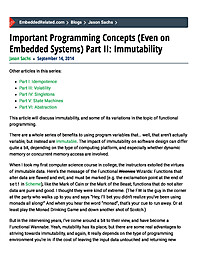
Important Programming Concepts (Even on Embedded Systems) Part II: Immutability
Other articles in this series: Part I: Idempotence Part III: Volatility Part IV: Singletons Part V: State Machines Part VI: Abstraction This article will discuss immutability, and some of its variations in the topic of functional...
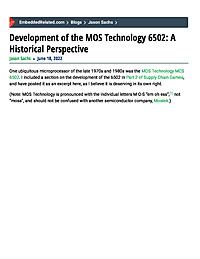
Development of the MOS Technology 6502: A Historical Perspective
One ubiquitous microprocessor of the late 1970s and 1980s was the MOS Technology MCS 6502. I included a section on the development of the 6502 in Part 2 of Supply Chain Games, and have posted it as an excerpt here, as I believe it is deserving...
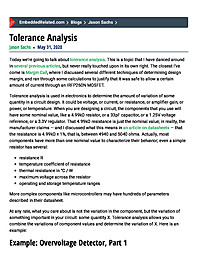
Tolerance Analysis
Today we’re going to talk about tolerance analysis. This is a topic that I have danced around in several previous articles, but never really touched upon in its own right. The closest I’ve come is Margin Call, where I discussed...
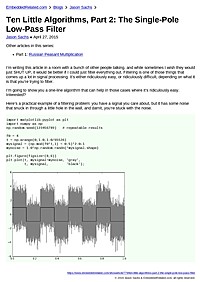
Ten Little Algorithms, Part 2: The Single-Pole Low-Pass Filter
Other articles in this series: Part 1: Russian Peasant Multiplication I’m writing this article in a room with a bunch of other people talking, and while sometimes I wish they would just SHUT UP, it would be better if I could just...
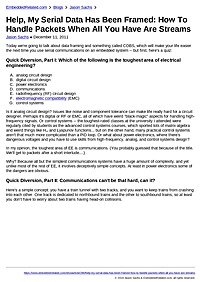
Help, My Serial Data Has Been Framed: How To Handle Packets When All You Have Are Streams
Today we're going to talk about data framing and something called COBS, which will make your life easier the next time you use serial communications on an embedded system -- but first, here's a quiz: Quick Diversion, Part I: Which of the...

Lost Secrets of the H-Bridge, Part IV: DC Link Decoupling and Why Electrolytic Capacitors Are Not Enough
Those of you who read my earlier articles about H-bridges, and followed them closely, have noticed there's some unfinished business. Well, here it is. Just so you know, I've been nervous about writing the fourth (and hopefully final) part of this...
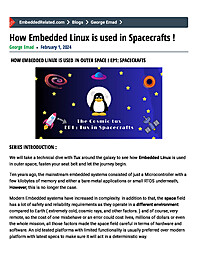
How Embedded Linux is used in Spacecrafts !
This article dives into the application of Linux in spacecraft, examining the challenges it poses and proposing potential solutions. Real-life examples will be discussed, while also addressing the drawbacks of employing Linux in safety-critical missions.
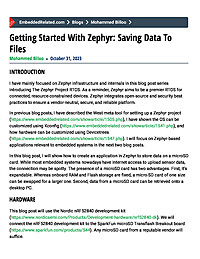
Getting Started With Zephyr: Saving Data To Files
In this blog post, I show how to implement a Zephyr application to mount a microSD card, create a new file on the microSD card, and write data to it. The lessons learned from such an application can be helpful for devices out in the field that need to write data to off-board memory periodically, especially in cases where Internet access may be sporadic.




















